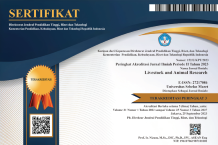Kecernaan nutrien dan performa ternak babi fase starter yang diberi pakan campuran bahan pakan limbah
Abstract
Objective: This study aimed to observe the effect of various combinations of by product feeds on feed and nutrient digestibility, and performance of starter pigs.
Methods: The experimental design was a Completely Randomized Design with 4 treatments and 3 replications. Treatment were: P0 (CP551 as a control diet), P1 (diets mixed of fish waste, tofu waste and vegetable leftovers), P2 (P1 + rice bran), and P3 (P2 + taro peelings). Twelve pigs at 2-months old with initial body weight about 5.49 to 9.20 kg (coefficient variance 16.37%) were used in this study. The pigs were fed the experimental diets for 4 weeks.
Results: Body weight gain (BWG) and feed consumption of starter pigs given P1, P2, and P3 were lower than P0. However, there was no significant effect found on feed conversion ratio (FCR). Feed treatments did not affect total feed digestibility, nevertheless effect on nutrient digestibility was only found on crude fiber (CF). Pigs given P0, P2, and P3 had CF digestibility higher than P1.
Conclusions: By-product diets had a negative impact on the performance of starter pigs. However, it had no effect on feed digestibility. The high content of CF in by-product diets was suggested to reduce the feed palatability in which consequently reduced feed consumption and body weight gain. The interactions of an individual fiber with other feed components in a diet could modify its physicho-chemical property which could impact on CF digestibility.
Keywords
Full Text:
PDF (Bahasa Indonesia)References
- Iyai, D., D. Woran, and I. Sumpe. 2010. Clustering, and principal component analyses of constraints in smallholding pig keeping systems in Manokwari, Indonesia. Anim. Prod. 12:199-206.
- Suroto, H. 2014. Babi dalam budaya Papua (Pig in the Papua culture). J. Pen. Arkeo. Papua dan Papua Barat. 6:37-44.
- BPS Papua Barat. 2015. Papua Barat dalam angka. Badan Pusat Statistik, Manokwari.
- Patience, J. F., M. C. Rossoni-Serão, and N.A. Gutiérrez. 2015. A review of feed efficiency in swine: biology and application. J. Anim. Sci. Biotechno. 6:33-49. Doi:10.1186/s40104-015-0031-2
- Budaarsa, K., A. W. Puger, and I. M. Suasta. 2016. Eksplorasi komposisi pakan tradisional babi Bali. Majalah Ilmiah Peternakan. 19:6-11. Doi:10.24843/MIP.2016.v19.i01.p02
- Septian, F., D. Kardaya, and W. D. Astuti. 2011. Evaluasi kualitas silase limbah sayuran pasar yang diperkaya dengan berbagai aditif dan bakteri asam laktat. Jurnal Pertanian. 2:117-124. Doi:10.30997/jp.v2i2.576
- Saud, R. H., V. R. W. Rawung, J. M. Soputan, and M. T. R. Lapian. 2019. Penampilan produksi ternak babi grower sampai finisher yang menggunakan tepung limbah ikan cakalang sebagai pengganti sebagian konsentrat dalam ransum. Zootek. 39:23-32. Doi:10.35792/zot.39.1.2019.22109
- Budaarsa, K., G. E. Stradivari, I. P. G. A. S. K. Jaya, I. G. Mahardika, A. W. Puger, I. M. Suasta, and I. P. A. Astawa. 2015. Pemanfaatan ampas tahu untuk mengganti sebagian ransum komersial ternak babi. Jurnal Ilmiah Peternakan Universitas Udayana. 18:226-239
- Pattiselanno, F. and D. Iyai. 2005. Peternakan babi di Manokwari: mempertahankan tradisi dan meningkatkan taraf hidup. Salam. 13:24-25.
- Lekitoo, M. N., S. Hartini, S. Lumatauw, D. D. Rahardjo, S. Y. Randa, and T. W. Widayati. 2014. Studi potensi pakan lokal untuk pengembangan peternakan babi di Kabupaten Manokwari. Laporan Penelitian. Kerjasama Fak. Peternakan Perikanan dan Ilmu Kelautan Universitas Negeri Papua dan Dinas Peternakan dan Ketahanan Pangan Prov. Papua Barat. Manokwari.
- Hartini, S., M. N. Lekitoo, S. Lumatauw, D. D. Rahardjo, S. Y. Randa, T. W. Widayati, and R. Siregar. 2015. Nutritive value of grower pig ration using local feeds in West Manokwari District, Manokwari. Proc. of 5th Int. Conf. on Sustain. Anim. Agric. for Develop. Count. 5:145-148.
- Noblet, J. and J. M. Perez. 1993. Prediction of digestibility of nutrients and energy values of pig diets from chemical analyses. J. Anim. Sci. 71:3389-3398. doi:10.2527/1993.71123389x
- Schneider, B. H. and W.P. Flatt. 1975. The evaluation of feeds through digestibility experiment. University of Georgia Press, New York.
- SPSS. 2007. SPSS 16.0 Command Syntax Reference. Inc. Chicago IL, Chicago.
- Wea, R. 2010. Performans produksi ternak babi yang mengkonsumsi limbah organik pasar. Partner. 17:127-135.
- Tiro, B. M. W., P. A. Beding, and R. H. S. Lestari. 2019. Profil peternakan babi di Distrik Wamena, Kabupaten Jayawijaya, Papua. Jurnal Pertanian Agros. 21:9-18.
- Mutua, F. K., C. Dewey, S. Arimi, W. Ogara, M. Levy, and E. Schelling. 2012. A description of local pig feeding systems in village smallholder farms of Western Kenya. Trop. Anim. Health Prod. 44:1157-1162. Doi:10.1007/s11250-011-0052-6.
- Tiro, B. M. W. and P. T. Fernandes. 2007. Kajian teknologi budidaya dan pengaruhnya terhadap penampilan ternak babi. Pros. Sem. Nas. BBPP. Teknologi Pertanian. 574-579.
- Nangoy, M. M., M. T. Lapian, M. Najoan and J. E. M. Soputan. 2015. Pengaruh bobot lahir dengan penampilan anak babi sampai disapih. Zootek. 35:138-150. Doi:10.35792/zot.35.1.2015.7223
- Siagian, P. H., S. Natasamita, and P. Silalahi. 2005. Pengaruh substitusi jagung dengan corn gluten feed (CGF) dalam ransum terhadap kualitas karkas babi dan analisa ekonomi. Media Peternakan. 28:100-108.
- Solà-Oriol, D., E. Roura, and D. Torrallardona. 2011. Feed preference in pigs: Effect of selected protein, fat, and fiber sources at different inclusion rates. J. Anim. Sci. 89:3219-3227. Doi:10.2527/jas.2011-3885
- Hartini, S. and M. Choct. 2010. The effect of non-starch polysaccharides derived from different grains on performance and digestive activity in laying hens. J. Indonesian Trop. Anim. Agric. 35:95-100. Doi:10.14710/jitaa.35.2.95-100
Refbacks
- There are currently no refbacks.










